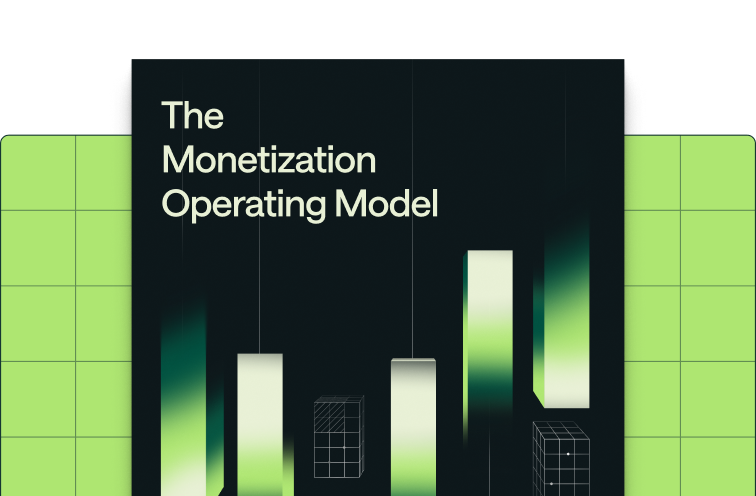Share
The business world is changing rapidly and fundamentally. Because software no longer just enables work — it does the work.
The cause of this rapid shift? Artificial intelligence.
AI is changing how software creates value. Instead of giving humans tools to accomplish tasks, software now automates decisions, completes workflows, and learns from data to improve outcomes.
This shift marks the beginning of the third era of software value:
- The Software Era was about features and licenses.
- The Access Era was about subscriptions and cloud delivery.
- The Value Era, which is happening now, is about work performed and outcomes delivered.
In other words, value has moved from what software offers (think Microsoft Office licenses), to what it enables (think Adobe Creative Cloud subscriptions), to what it actually does (think OpenAI charging for tokens used to generate content).
The problem is: while software has entered the Value Era, most monetization systems haven’t.
Most companies still price software using Access Era thinking by charging for seats and subscriptions, even as their software delivers real value through outcomes and automation.
Companies that adapt their billing to match how their products actually deliver results—through automation and usage—win more deals, launch AI features faster, and grow revenue as customers scale. Those who don’t face growth constraints as AI makes seat-based pricing obsolete.
When billing doesn’t reflect how software delivers value, it creates both urgent risk and missed opportunity.
This guide breaks down the three eras of software value, the rise of outcome-based billing, and what teams need to do to stay ahead.
The three eras of software value
Software value has undergone three fundamental transformations, each redefining how companies capture, deliver, and measure success. These shifts represent pricing evolution and changes in what software does and how businesses operate.
Era 1 - The software era (1990s): value = features and licenses
In the 1990s, software became mainstream. In this era, companies bought software like they bought packaged equipment. The value was measured by features, not usage.
Companies bought perpetual licenses with big upfront payments and annual maintenance fees. Success meant closing deals and keeping customers paying for updates, not driving outcomes.
The result was shelfware, software that companies bought but never actually used. Microsoft Office in shrink-wrap boxes exemplified this era. Customers paid hundreds of dollars for features they might never touch.
The basic problem was misaligned incentives. Customers paid regardless of usage. Vendors optimized for feature bloat rather than user outcomes. Software sat unused on countless desktops across enterprises.
Era 2 - The access era (2000s-2010s): value = subscriptions and cloud access
In the 2000s, cloud computing redefined how software was delivered. In this era, companies no longer owned software; they subscribed to it. The value turned into access instead of features.
Instead of making large upfront purchases, customers paid for monthly or annual subscriptions to access software hosted in the cloud. This shift turned software from a capital expense into an operating one, and made deployments faster, cheaper, and easier to manage
Success metrics evolved to annual recurring revenue, net dollar retention, and churn rates that reflected customer satisfaction over time.
Adobe's 2013 transition from Creative Suite licenses to Creative Cloud subscriptions demonstrated this perfectly. Customers gained access to continuously updated software for predictable monthly fees.
But this model introduced a new limitation: subscription pricing remained disconnected from actual consumption and outcomes. Customers paid the same whether they used the software intensively or barely touched it.
Access was no longer the barrier, but value still wasn’t tied to impact.
Era 3 - The value era (now): value = work performed and outcomes delivered
Today, software performs the work itself. In the Value Era, value comes from outcomes delivered, not access granted.
AI and automation have transformed software from a set of tools into an active participant that performs work autonomously. Value comes from completed workflows, automated tasks, and decisions made by systems without human intervention.
Pricing models have shifted to reflect this change. Companies now pay for usage, outcomes, and work, which is why modern software uses outcome-based pricing models OpenAI's token-based pricing is a clear example: Customers pay for actual AI work performed, not seat access to AI tools.
AI breaks the access model because it performs labor autonomously. When software writes code, generates content, or makes decisions, charging for seat access makes as much sense as charging lawyers by the number of law books they can access rather than the legal work they complete.
This model creates better alignment between vendor economics and customer outcomes. Companies pay more as they get more value. Vendors benefit directly from customer success rather than from selling unused capacity.
{{widget-monetization-whitepaper}}Why the value era is inevitable
The Value Era is inevitable because AI has changed how software creates and delivers value. And that change demands a new way to charge for software.
As software shifts from providing access to performing work, traditional seat-based pricing breaks down. A new model is emerging: outcome-based pricing. Instead of charging for users, companies charge based on usage, results, or work completed.
Three forces are making this pricing innovation and structural change unavoidable: the nature of AI workloads, evolving customer economics, and market pressure to unlock new growth.
The AI catalyst
AI changes how software operates and how value is delivered. It transforms software from productivity tools to autonomous systems that actually do the work.
AI systems work differently from traditional software. They consume compute-intensive workloads with unpredictable usage spikes that don't correlate with user count. AI systems optimize, iterate, and act on their own, creating value continuously in ways customers didn't explicitly initiate.
When software performs human-level work, like writing code, generating campaigns, and analyzing data, pricing must reflect the work done, not how many people log in. AI shifts the unit of value from access to output.
That shift makes usage-based, outcome-based, or hybrid billing a necessity, not a nice-to-have.
The value mismatch
A value mismatch happens when pricing doesn’t reflect how much value each customer actually gets. AI makes that gap impossible to ignore, making the Value Era inevitable.
Two companies might use the same AI product, but get very different results. One automates hundreds of tasks and unlocks major productivity gains. Another uses it lightly and sees limited benefit.
Yet both are charged the same flat subscription fee. Because flat-rate pricing can’t account for that variation.
That disconnect can erode trust, invite churn, and limit expansion. When pricing isn’t aligned with value delivered, high-performing customers feel undercharged, low-usage customers feel overcharged, and vendors miss out on growth tied to customer success.
As AI drives bigger performance gaps between users, outcome-based billing becomes the only way to keep pricing fair, scalable, and aligned with real-world impact.
Market pressure
AI is increasing productivity per user, which means customers need fewer seats. But companies still need to grow.
As AI helps individuals do more with less, software delivers more value without requiring more users. That puts direct pressure on seat-based pricing: customers get more done with fewer licenses, and revenue growth stalls.
But the market still demands growth. Public companies are expected to expand revenue year over year. Startups are expected to scale fast. That creates a gap: more value is being delivered, but the pricing model can't capture it.
Usage-based pricing fills that gap. It lets revenue scale with consumption and outcomes—not headcount. That’s why high-growth companies like Snowflake and Databricks use it—and why 64% of Forbes’ next billion-dollar startups do too.
Strategic implications for today's leaders
Value-based pricing requires coordinated changes across product, finance, and engineering. Each team must work differently as value delivery becomes dynamic and measurable.
This shift affects how products are built, how revenue is forecasted, and how systems are designed. Success depends on having the right data, infrastructure, and cross-functional alignment to support dynamic pricing at scale.
Finance leaders
Usage-based pricing turns revenue into a moving target, which means finance teams need real-time visibility, flexible models, and stronger controls to keep up.
Finance teams need daily, if not hourly, revenue visibility as a north star for internal alignment and faster decisions.
Accurate forecasting depends on understanding how customers use the product, meaning seasonality, behavior shifts, and consumption trends all matter. This requires real-time usage data, rich meta data, integrated systems, and stronger analytical capabilities.
Another change that comes with usage-based pricing is that margins fluctuate. As usage patterns shift, so do costs and profitability. Finance teams must build models that adjust to changing customer behavior and product performance.
Finally, usage-based pricing introduces new compliance and audit challenges. Tracking credits, multiple pricing dimensions, and outcome-based billing demands audit-grade systems because basic reporting tools won’t scale.
Product directors
Product teams need to design around measurable outcomes rather than feature access. Instead of building features that justify seat expansion, product teams must create capabilities that drive measurable value that can be tracked and billed.
Product teams need the ability to test new pricing models, adjust value metrics, and respond to market feedback without waiting for engineering sprints or technical implementations. Pricing iteration without engineering bottlenecks becomes critical for a competitive response.
Building billing and cost dashboards becomes core product work, not an afterthought. Customers need real-time visibility into usage, costs, and value realization to feel comfortable with variable pricing. Transparent consumption data becomes a product feature that builds trust and enables optimization.
Engineering managers
Engineering teams must instrument systems to capture granular usage data, measure value delivery, and provide accurate consumption metrics that support various pricing models. Real-time usage tracking and outcome measurement become architectural requirements.
That being said, they also need to keep billing logic separate from your product code. When billing and product get tangled together, every pricing change breaks something. Hardcoded pricing logic creates technical debt that slows pricing iteration and increases maintenance overhead. Modern systems need flexible pricing engines that evolve independently from product features.
Every pricing change should not require code deployments, database migrations, or system downtime. Technical architecture must support business model evolution without breaking existing systems.
Engineering teams must build systems that serve product, finance, and customer success teams with consistent, real-time data. Automated data sharing from a single source of truth eliminates the manual reconciliation that plagues usage-based billing.
The cost of staying behind
Sticking with Access Era pricing slows growth, blocks AI adoption, and creates technical debt that compounds over time.
Competitors with modern billing models move faster, capture more revenue, and align pricing with the value their products deliver. The longer companies wait to adapt, the more costly and complex the transition becomes—both operationally and strategically.
Competitive disadvantages
Companies lose the AI competition when they can't launch AI features with pricing that customers feel comfortable paying for. Keeping seat-pricing and simply raising that seat price can create customer resistance to AI adoption because the pricing model doesn't align with AI value delivery.
You miss expansion opportunities tied to customer success and outcomes when competitors can scale revenue with customer value realization. Usage-based models unlock expansion revenue that grows automatically with customer success.
Engineering teams get stuck maintaining pricing logic instead of building product features when billing systems need constant manual intervention. Technical debt from hardcoded pricing pulls engineering resources away from core product development.
Finance teams lose predictive capability when subscription models don't reflect actual consumption patterns. Revenue forecasting becomes unreliable as customer usage patterns diverge from seat counts.
The compounding problem
If every pricing change is a three-sprint project that delays product features when billing logic is embedded in product code, pricing innovation slows product development, which hurts competitive positioning.
Engineering teams get pulled into billing tickets and customer escalations instead of focusing on core product development. Manual billing processes create operational overhead that scales poorly and pulls technical talent away from value creation.
Manual billing processes leak revenue. At scale, you're losing real money to errors and disconnected systems. Usage-based billing needs precision and automation that manual processes can't provide reliably.
Customer churn increases when pricing doesn't reflect the value received. Customers see pricing as a blackbox for variable value delivery eventually question the relationship between costs and benefits, especially when AI-native competitors offer aligned pricing.
Market examples
AI-native companies launch with usage-based models from day one, creating pricing expectations that traditional seat-based competitors can't match. These companies capture market share by offering pricing that scales with customer success.
Traditional SaaS companies find themselves forced to add usage elements to stay competitive. They often retrofit usage capabilities onto subscription architectures that weren't designed for variable pricing. This creates technical debt and operational complexity that purpose-built systems avoid.
Building for the value era
Moving to Value Era monetization demands a new operational infrastructure designed for how modern software creates value.
The three eras represent tectonic shifts in value creation, not just pricing evolution. Companies can't simply add usage pricing to Access Era infrastructure and expect Value Era results. The underlying systems, processes, and organizational capabilities must evolve to support dynamic value delivery and measurement.
AI acceleration makes Value Era adoption urgent, not optional. Companies have a narrow window to adapt before AI-native competitors capture market share with better-aligned pricing models. The transformation timeline is compressed because AI adoption happens faster than previous technology shifts.
Companies need monetization infrastructure as sophisticated as their products. When software performs autonomous work, billing systems must match that sophistication with real-time usage tracking, flexible pricing models, and automated value measurement.
Winning in the Value Era means connecting what customers pay to what they actually get. Companies must build capabilities that connect product usage to business outcomes, financial performance, and customer success metrics. No more guessing about value.
{{widget-monetization-whitepaper}}
.png)










